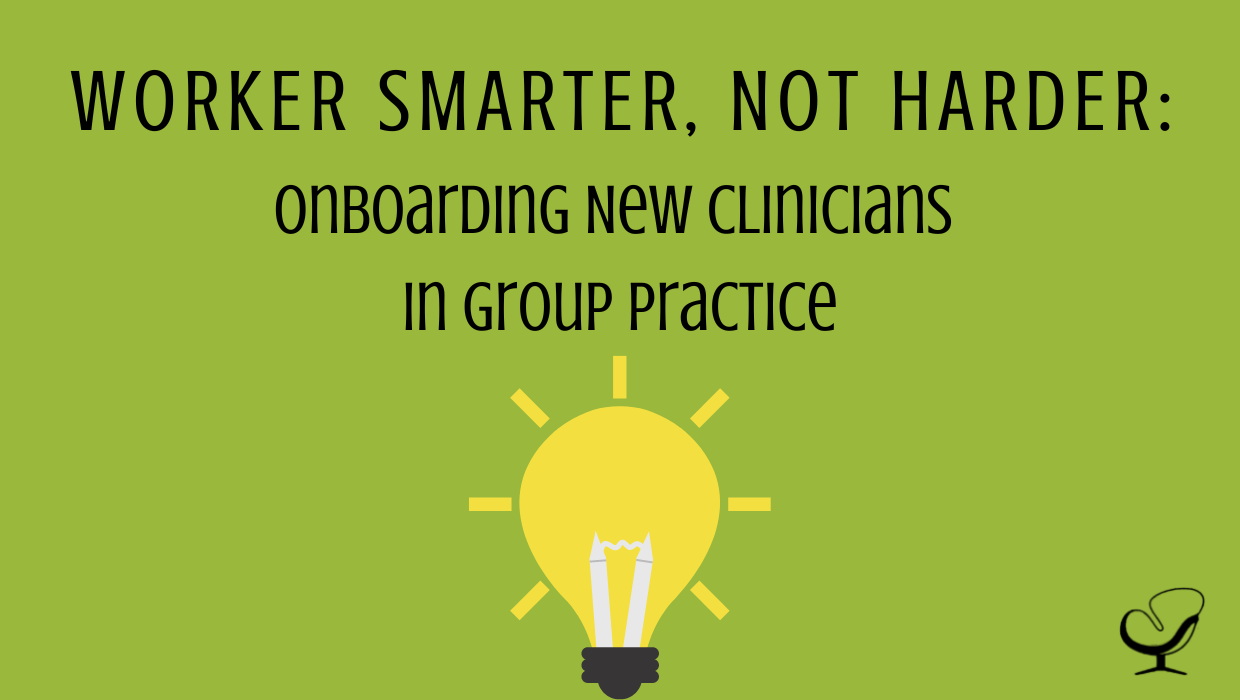If you are a group practice owner, you will have or have had the chance to onboard new clinicians on a regular basis. You’ve recruited, interviewed, and offered new therapists or other clinicians a job with you, and they have accepted. Yay! Now, how do you bring on this new clinician in a way that isn’t a time suck for you?
You want to work smarter, not harder, right? As a group practice owner, you wear many hats. You don’t have the time or energy to spend 5 hours each week training and onboarding a new clinician. But your new clinician does need support, guidance and information. Here is a system that you can use to onboard future clinicians so that it goes smoothly and doesn’t take all of your time.
Create a training checklist

The more time you take to prep your onboarding process, the less time you will spend scrambling at the last minute to figure out what your new clinician needs to know. Regardless if this is your first clinician hire or your 5th, spend 30 minutes before their start date to create a training checklist. Put everything on this list that you can think of that your new person needs to know.
Continue to refine this list over the next few days or weeks. Perhaps if you’ve recently hired someone, check back in with that person and ask them what they would like to have on this checklist or what they wanted to know during their onboarding process. Once you have this checklist, create an Original Copy that you can continue to edit, then make a separate copy for your new hire that is sharable and usable by everyone involved.
Delegate who does what training

You now have your Training Checklist, but it’s daunting! Remember, you don’t have to personally train your new hire on everything on this checklist. If you have admin staff, a VA, or anyone else on your team who you can recruit to help you train, do it. Oftentimes they might even know more than you do about the training topic.
Maybe it’s hard to hand off some things to others, but the benefit is that your new hire will have many different perspectives on things other than just yours. And if this is your first hire, imagine who else could be doing this training for future hires. Delegate down the training checklist until you’re doing between ¼ to ½ of the training, and then breathe a sigh of relief that you’re not responsible for everything!
Record trainings that don’t require personalization

Are there some rote or administrative trainings that aren’t unique to this particular clinician being trained? For example:
- Training on an email or phone system
- Reviewing the Policies and Procedures Manual
- Educating about employee benefits, payroll system, or payment collections process
- Discussing your practice’s Mission, Vision and Goals
- Talking about your marketing strategies
- And more…
All of these things can be recorded once by you, or whoever is doing the training, and then played for future hires. It does take a bit more time upfront to plan and record these trainings, but in the long-run it will save you valuable time. And remember, the recordings don’t have to be perfect. Just be yourself, explain and train away, and send it to your new hires so you can free up some valuable time in your schedule!
Be clear with your expectations

Another thing that will save you much time in the long run is to be very clear with your expectations of your new hires. If possible, put as many of your expectations as possible into the offer letter, job description, or independent contractor agreement. Be clear about the minimum number of hours/sessions per week your new clinician needs to offer and/or fill. Communicate your needs about who does what marketing, and what benefits/materials you’re providing.
Being crystal clear with your expectations will set both you as the practice owner, and your new clinician, at ease. Having set benchmarks also makes it easier to have tough conversations down the road, as it can take the emotion out of making a difficult decision.
Create a buddy check-in system

If you have a group practice, ask someone on your team if they are willing to be a new-hire “buddy”. This person can check-in regularly with the new clinician, be a first contact if they have any basic questions, and provide some support the first few weeks of a new job. Having a designated person, other than yourself, for your new clinician to turn to first will again free up some of your time from answering basic questions like “how do I complete a timesheet”.
Set up regular intervals to meet

While you do want to delegate onboarding and training as much as possible, you don’t want to ignore your new hire. Set up a system for regular meetings over the first month or two of the job. Perhaps an end-of-the-week email exchange would work well for virtual practices, or you can schedule a more formal 30 to 60 minute meeting weekly for the first month.
Decide who is going to be your new clinician’s administrative manager. Usually that’s you as the practice owner, but in some cases it may be someone else. If you hired a provisionally-licensed therapist who is going to be getting clinical supervision from another member of your team, make sure the roles and meetings between administrative and clinical supervisors are discrete.
Review progress after 90 days

While not required, it’s nice to put into place a 90-day review system. That means setting the expectation up front that after 90 days of hire, you and your new clinician sit down and review how things are going. You can make this a more formal review and create a 90-Day Review List, or this can be more informal. Since you have already set your expectations upfront with your new clinician, the 90-day review should be easy-peasy for you.
What do you think? Does this make it easier for you to create a system for onboarding a new hire? It just takes a bit of preparation work for your next new hire, then all future new hires will benefit from this system that you’ve put into place. Not to mention your own schedule will thank you, and you’ll feel much more organized and less stressed when bringing on future new hires.
Previous Articles By Shannon For Group Practice Owners:
Take It From One Group Practice Owner: Things You Shouldn’t Do
Take It From One Group Practice Owner: Things You Should Do
How to Get Through the Holidays as a New Group Practice Owner
Setting Up Your Group Practice Website
How to Find Good Therapists to Hire for Your Group Practice
How to Hire Your First Therapist When You’ve Never Hired Before
Don’t Settle When Hiring Clinicians
Hiring Your First Clinician, Part 1
Hiring Your First Clinician Part 2
Hiring Your First Clinician Part 3
Shannon Heers

Shannon Heers is an experienced therapist, clinical supervisor, and the founder of FirelightSupervision. Firelight Supervision provides clinical supervision and clinical consultation to counselors and social workers pursuing licensure, as well as post-licensure professional development. Shannon is also the owner of Catalyss Counseling, a group private practice located in Colorado. Shannon specializes in providing clinical supervision to beginner to advanced therapists, and is passionate about burnout prevention in the counseling field.

